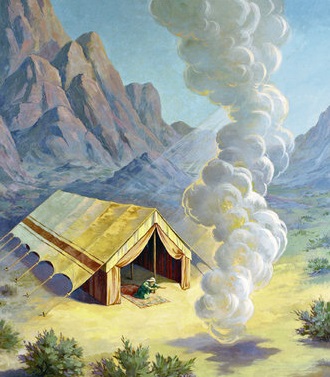This article is part of a series on Old Testament Christophanies. For important background information, see An Introduction to Old Testament Christophanies–with Justin Martyr.

Exodus 33 follows the incident of the people worshipping the golden calf. In this chapter, the Lord spoke to Moses, telling him that the Israelites would continue their journey to the Promised Land, so that it would be given to their descendants. And He added that an angel would still go before them and drive out the inhabitants. However, the Lord Himself would not be in their midst, so that He wouldn’t end up destroying them on the way (vv. 1–3).
Because the Lord said that He would no longer be in their midst, it is argued that now only a created angel would be leading them and not the divine Angel. However, this angel (also mentioned in Exodus 32:34) is only said to go before them, not that he would be in their midst. Therefore, it is likely that this is still the Angel with Yahweh’s name in Him from Exodus 23. In any case, the question is academic, as the Lord would soon answer Moses’ prayer, promising that His presence would go with the Israelites (vv. 12–17).
Upon hearing the bad news, the people went into mourning. They obeyed the Lord’s command to remove their ornaments. The people stopped wearing them from Sinai onward, to signify their continued contrition (vv. 4–6).
It is at this point where we are introduced to the Lord’s appearances at the Tent of Meeting (not to be confused with the Tabernacle, which was yet to be built). Moses would take the tent and pitch it a good distance away from the camp. Moses himself named it the Tent of Meeting. Everyone who sought the Lord would go out to it. Whenever Moses entered into the tent, the Israelites would stand at the entryway of their own tents and wait in anticipation. For after Moses would enter the tent, the pillar of cloud would descend, “stand” at the entrance and “the LORD would speak with Moses” (vv. 7–9). According to the Targum, “the glorious Cloud descended and stood at the door” and it was “the Word of the Lord” who spoke to Moses.[1] When the people beheld the pillar of cloud standing at the tent, they arose to worship. “Thus the LORD used to speak to Moses face to face, just as a man speaks to his friend.” While Moses would return to the camp, Joshua remained in the tent (vv. 10–11).
Moses evidently moved the tent outside of the camp since the Lord wouldn’t visit a place in the midst of the people. The tent’s location would have served as a visual representation that the Lord was no longer among them. Even after the people’s apostasy, the Son of God still visited with Moses. As He descended, the pillar of glory around Him was all that could be seen. It wasn’t the pillar itself standing at the entrance of the tent, but the Lord, surrounded by His glory. From within the pillar the Lord spoke to Moses. The idiom “face to face” is used here to communicate the great intimacy Moses had with the Lord. Such an expression of intimacy would hardly make much sense if the Lord wasn’t actually there. According to Deuteronomy 34:10, the Lord knew Moses “face to face.” Moses couldn’t literally see God’s face through the pillar, but He was just behind the veil of glory.
The Lord spoke directly to Moses’ face with familiarity, as a friend would. Unlike the people, Moses obeyed the Lord, becoming His friend. For the same reason, Jesus called His disciples friends:
You are my friends if you do what I command you. No longer do I call you slaves, for the slave does not know what his master is doing; but I have called you friends, for all things that I have heard from My Father I have made known to you (John 15:14–15).
Like He did with His friends the disciples, the Son of God revealed the will of the Father to His friend Moses.
[1] Targum Pseudo-Jonathan on Exodus 33:9.

Leave a Reply